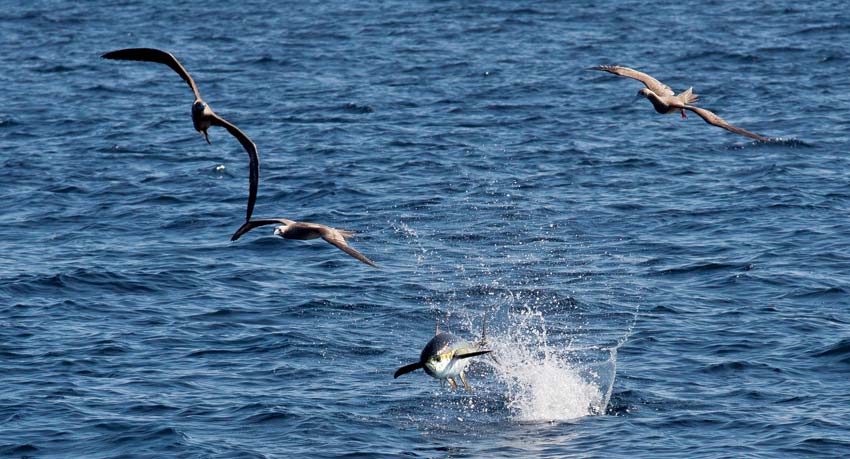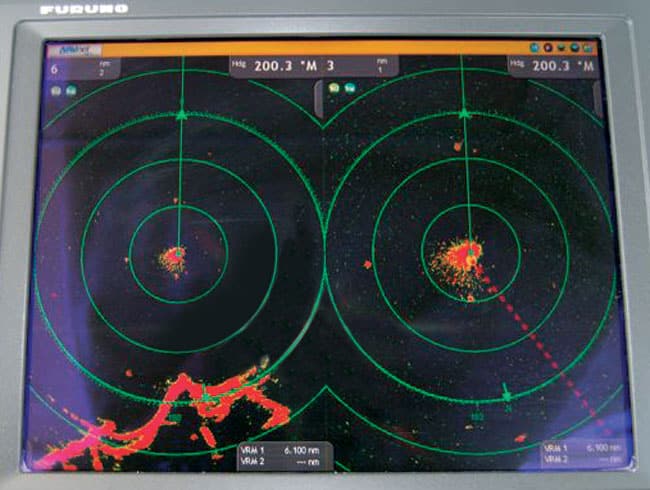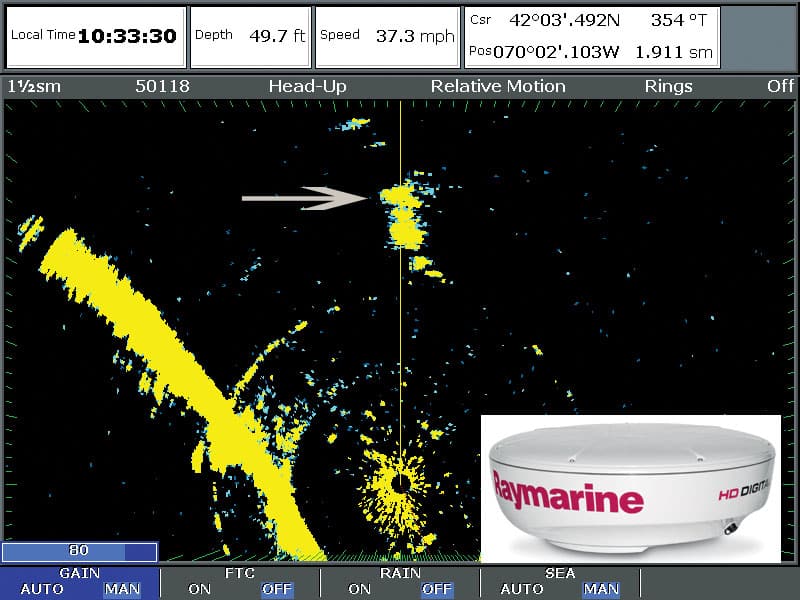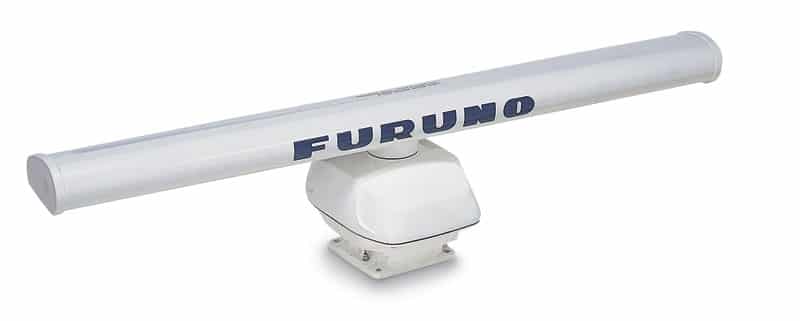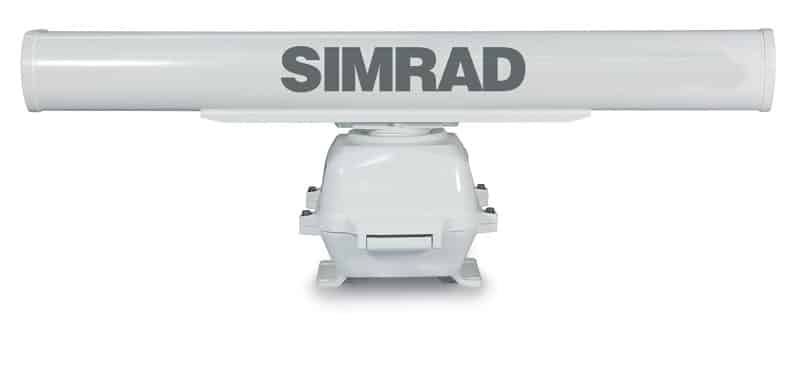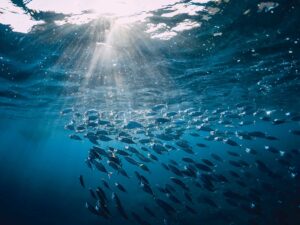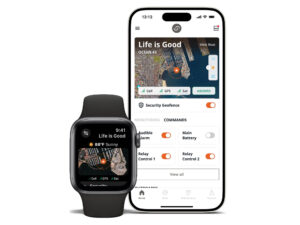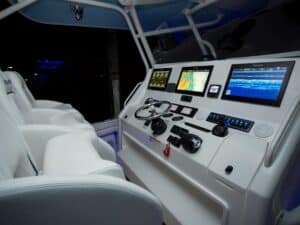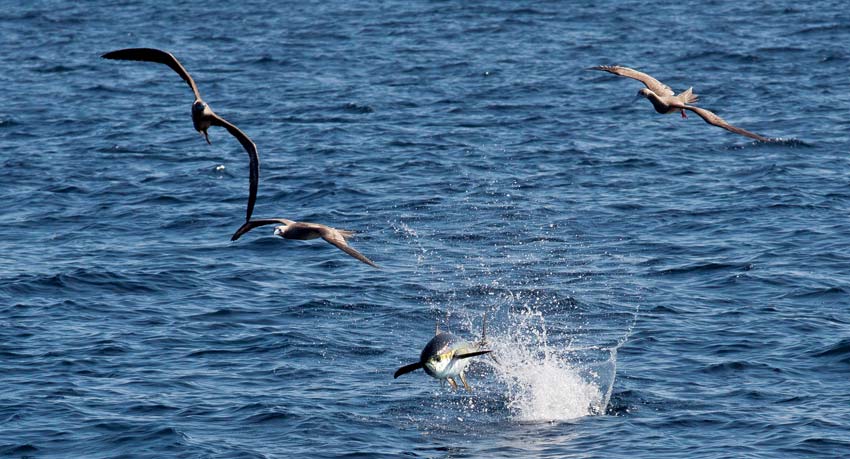
tuna birds
Birds elicit mixed emotions from anglers. A bird that assaults your live bait prompts curses, but a bird that leads you to tuna wins praise. For captains who covet the latter, radar becomes the primary onboard electronic tool.
“If I had to pick a single piece of electronics on my boat to go catch fish, without a doubt, it would be my radar,” says Capt. Ed Dwyer, who runs Ticket Sportfishing Charters (321-288-1940, www.ticketfishing.com) out of Port Canaveral, Florida. Dwyer uses a 25 kw Furuno radar (6-foot open array) with a NavNet 3D system aboard his 62-foot Paul Spencer. That large, sport-fishing vessel can carry the heavy weight (62 pounds) of such an antenna, and with it, radar performance can prove remarkable.
“I can mark a single frigate bird at six miles,” Dwyer says. “I can even see weed lines six to seven miles away if there’s any kind of swell.”
Size Can Matter
“More power is better,” says Eric Kunz, Furuno senior product manager, but that’s not the only factor in radar performance. Transmitter power, the antenna’s ability to focus energy and the receiver’s sensitivity all contribute to quality. Add to that the height of the antenna off the water, and you dial in success.
But can small-boat radar perform well enough to help anglers improve their fish finding? Massachusetts captain Terry Nugent (774-696-0420, www.riptidecharters.com) says yes — out to a certain distance. Nugent runs a 33-foot Contender center-console and uses Raymarine’s 4 kw HD dome (22 pounds) with E140W and E90W displays.
“We got birds one day at 3.8 miles,” Nugent says. “I can consistently get birds at two-and-a-half to three miles. It’s not an exact science, but 95 percent of the time it works for us. It saves me so much time and so much fuel.”
Capt. Bill Platt fishes the Southern Kingfish Association pro tour from a 36-foot Invincible center-console. He recently upgraded his Garmin radome to a 604HD 6 kw open array. “I had an aluminum top on my old boat, but now I have a fiberglass hardtop,” he says. “I run the boat wide open and have had zero problems.”
Platt, who operates Custom Marine Electronics in League City, Texas, uses radar for finding birds primarily during East Coast tournaments. “How far away I can see birds depends on how high they are. If they get up a bit, I’ll pick them up at three to four miles.”
**
Seeing Is Believing**
Sea conditions and weather play major roles in the mere ability to find birds. But the basic process of adjusting the radar is simple and virtually the same for any unit. “Reduce rain and sea clutter to bare minimum until you start to pick up slight clutter on your screen, and increase gain so the radar becomes very sensitive to small targets,” says Capt. Mark DeBlasio of Canyon Runner Sport Fishing (646-239-5566, www.canyonrunner.com) in Point Pleasant, New Jersey. DeBlasio uses a Simrad 10 kw open array with an NSE multifunction display.
Nugent says the first time he used radar he “found birds, then backed off a mile or so and tuned them in.” Birds on a screen “kind of look like a sponge painting,” he says.
Look for returns that appear more faint than solid. Birds also move, so a flock’s position and the shape of the return change — like an amoeba, he says — with each sweep. Nugent says his HD dome features a bird mode that speeds up the sweep so he can more easily see the flock’s movement.
Both Nugent and Dwyer say a dark background offers better contrast against the clutter and targets. But Nugent prefers a monochrome setting for returns, while Dwyer uses true color — a feature available on higher-end radars, which shows returns in reds, greens and yellows based on strength. He also uses a split-screen, dual-range function that’s common for many top units, though in some cases, the function is available only with specific displays.
“With my NavNet 3D, I have two screens, and it’s like having two radars. I tune one screen for navigating and one for birds,” says Dwyer. “There’s often good tuna fishing around rain squalls; the tuna like the cooler water. But the bird screen is so tweaked out when there’s rain that I can’t see a buoy or a boat.”
Dwyer also uses split screens to show different distances, setting one at eight miles and the other at three. The patterns the birds make tell him what he needs to know. “On the east side of the Gulf Stream, yellowfin tuna move north and skipjack tuna move south,” he says. Consequently, birds traveling north attract his attention.
“Stationary is also good,” he says. “If they’re moving too fast, they’re just looking. If they’re in one place, they’re feeding.”
On rough days, Dwyer plans his fishing based on the wind direction. He runs into the wind in the morning, then fishes down-sea so most of the sea clutter is behind him.
Because he chases birds at 35 to 40 mph, Nugent sets his preferences to position his boat icon at the bottom of the screen. “What’s behind me doesn’t matter,” he says.
All in the Install
Two other issues that affect how well radar finds birds pertain to installation: voltage input to the unit and the antenna placement. “Your screen should clutter out completely with the gain all the way up,” Dwyer says. “If not, the voltage coming into the unit isn’t right.”
The installer should place a voltmeter on the positive and negative lines into the unit to make sure all volts in a 12- or 24-volt system are present.
The dome or array should be placed at the proper attitude relative to the boat’s running position. “A lot of times when the boat’s running and the bow is high, you miss a lot. The radar is shooting up in the sky,” he says. “When you slow down, maybe everything looks good. But it’s when you’re running that you want to find birds.”
